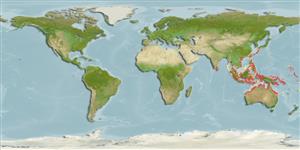Common names from other countries
>
Ovalentaria/misc (Various families in series Ovalentaria) >
Pseudochromidae (Dottybacks) > Congrogadinae
Etymology: Congrogadus: Latin, conger = conger + Latin, gadus = a fish, perhaps cod (Ref. 45335).
More on author: Richardson.
Environment: milieu / climate zone / depth range / distribution range
Écologie
marin; saumâtre récifal; profondeur 0 - 10 m (Ref. 90102). Tropical; 35°N - 25°S
Indo-West Pacific: Nicobar Islands, Andaman Sea and Japan to the tropical coasts of Australia.
Length at first maturity / Taille / Poids / Âge
Maturity: Lm ?, range 20 - ? cm
Max length : 45.0 cm TL mâle / non sexé; (Ref. 3132)
Épines dorsales (Total) : 0; Rayons mous dorsaux (Total) : 68 - 74; Épines anales: 0; Rayons mous anaux: 57 - 66; Vertèbres: 74 - 84. Coloration varied, capable of changing its color. Spots or blotches on body form reticulations and crossbands; paler ventrally. Gill membranes ventrally free from the isthmus. Posterior otic sensory canal pore present. Cephalic sensory canal pores not pigmented.
Inhabits coastal waters, often in brackish conditions (Ref. 48636). Found hidden amongst rocks or coral rubble (Ref. 48636). Reproductive activity appears to be cyclical and the species may not be a protogynous hermaphrodite (Ref. 2077). Also found in coral reefs among crevices (Ref 90102).
Life cycle and mating behavior
Maturities | Reproduction | Spawnings | Egg(s) | Fecundities | Larves
Winterbottom, R., 1985. Revision and vicariance biogeography of the subfamily Congrogadidae (Pisces: Perciformes: Pseudochromidae). Indo-Pac. Fish. (9):34 p. (Ref. 531)
Statut dans la liste rouge de l'IUCN (Ref. 130435)
CITES (Ref. 128078)
Not Evaluated
Menace pour l'homme
Harmless
Utilisations par l'homme
Pêcheries: commercial; Aquarium: Commercial
Outils
Articles particuliers
Télécharger en XML
Sources Internet
Estimates based on models
Preferred temperature (Ref.
115969): 25.2 - 29.3, mean 28.6 (based on 2277 cells).
Phylogenetic diversity index (Ref.
82804): PD
50 = 0.5156 [Uniqueness, from 0.5 = low to 2.0 = high].
Bayesian length-weight: a=0.00389 (0.00180 - 0.00842), b=3.12 (2.94 - 3.30), in cm Total Length, based on all LWR estimates for this body shape (Ref.
93245).
Niveau trophique (Ref.
69278): 4.0 ±0.67 se; based on food items.
Résilience (Ref.
120179): Milieu, temps minimum de doublement de population : 1,4 à 4,4 années (Preliminary K or Fecundity.).
Fishing Vulnerability (Ref.
59153): Low to moderate vulnerability (35 of 100).
